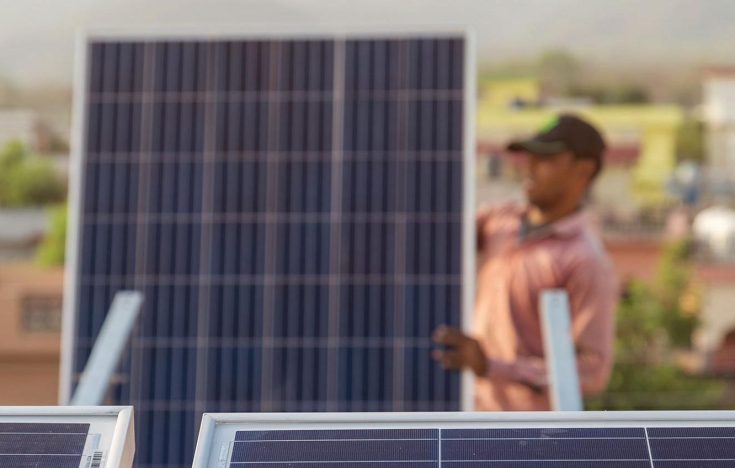India’s economy has shifted up a gear in recent
years and is likely to remain one of the fastest growing of the world’s top 20,
outstripping even regional powerhouse China.
To supply the energy needed to sustain this breakneck
growth while also meeting development and environmental targets poses an
enormous challenge for the government – which has put solar power at the heart
of its solution.
The lure of clean, renewable energy from the sun
is clear. More than 300 million of the country’s 1.3 billion people have no
access to electricity; soot from dung-, wood- and kerosene-fuelled ovens and
coal-fired power stations means the nation hosts 13 of the world’s 20 most
polluted cities; meanwhile, fuel imports drain the government’s coffers and
reduce energy security.
As the government strives to achieve these goals, India’s private sector is rapidly earning an enviable reputation as a solar energy innovator, piloting a series of micro-energy projects that could be rolled out to other electricity-poor nations across the developing world.
Sceptics point to lagging rates of installations and adoption because of high financing costs, uncertainty over government regulations and infrastructure investments, as well as poor returns from low-quality imported Chinese solar panels.
Better not cheaper
All of the barriers are surmountable given the right frame of mind counters Ritesh Pothan, a co-founder of Indian renewable energy consultancy Natural Group.“It’s quite doable, it’s just that mentally people have to stop putting in more hurdles,” he says, adding that one of the biggest impediments to solar’s success has been a race to the bottom for ever-cheaper panels.
“The typical thought process in India is that the cheapest is the best. The process has to move towards quality. That is very, very, very important,” he says.
Another criticism has been the slow rate of rooftop installations.
Of the 100GW target, fully 40GW is to come from wiring up roofs in government buildings, factories and residential properties. The decentralized nature of these residential projects – think that at roughly 2kW of installed capacity on average, it would take about 500 homes to reach 1WM – means the administrative process is more complex and costly, says Arun Ginjala, a consultant at The Lantau Group.
“There is a battery and inverter in every house,” adds Pothan. “You have 20 gigawatts of installed capacity right there. You just have to integrate it into the grid.”
Managing demand spikes
That also means cracking the storage problem: Solar, like wind power, is intermittent; coal-fired plants provide regular supply, but can’t be easily switched on or off. One solution is to use hydropower – which can be turned on or off like a tap. At times of excess solar supply, water can be pumped into dams and used to turn turbines in times of spiking power demand, Pothan says.Solar energy firms are exploring both small scale and large area solar parks, as both present advantages and challenges for customers and electricity generating companies.
Large solar parks come with several benefits for producers, such as land already cleared, infrastructure such as roads and transmission systems, and access to water, adds Ginjala.
“It is easier to raise finance at a lower cost for individual producers within the park. It also ensures that off-take is guaranteed, or else underwritten, which again reduces risk,” he says
Rolling out solar panels in rural areas is especially important in a country where cooking, pumps and tractors account for around a fifth of total energy consumption.
“The villages which we do are not even on Google Maps. They are off-grid and off-road,” says Paras Loomba, founder of Global Himalayan Expedition, a social enterprise that has installed microgrids in 41 remote villages in northern India’s Ladakh district, improving the lives of 18,000 people and helping to displace polluting and expensive diesel generators.
Overseas investment
To roll out grids, the company has created teams of entrepreneurs, who can install them in resorts, hotels and villages. Falling prices have meant that hardware now makes up only about 40% of the cost of installing a grid, from about 70% a few years ago, he said. That puts more money in the pockets of the local community.Global Himalayan Expedition’s model – which uses DC-only technology that Loomba says cuts energy losses from converting to AC – is drawing interest from countries tackling similar problems of wiring up remote communities in Africa and Latin America.
India’s solar plans are also drawing investment from overseas. AES, the US power group, and Japan’s Mitsubishi are building a 10 MW storage bank for Tata Power in Delhi. South Africa’s Phelan Energy Group and EdiSun of America have also won bids to supply solar power.
India’s ambition is helping catapult the country into a role as a global leader and centre for the solar industry. The International Solar Alliance is one example of this. Founded by Prime Minister Narendra Modi, the 121-strong group comprises all major tropical countries and has won commitments for $1 trillion in funding to meet emission reduction targets for 2030.
At the end of the day, says Loomba, grids are “aspirational.”
Tomorrow if a guy has a light, he can ask for a TV. The next day he can ask for a grinder. So you can fulfil your aspirations in these villages.”
